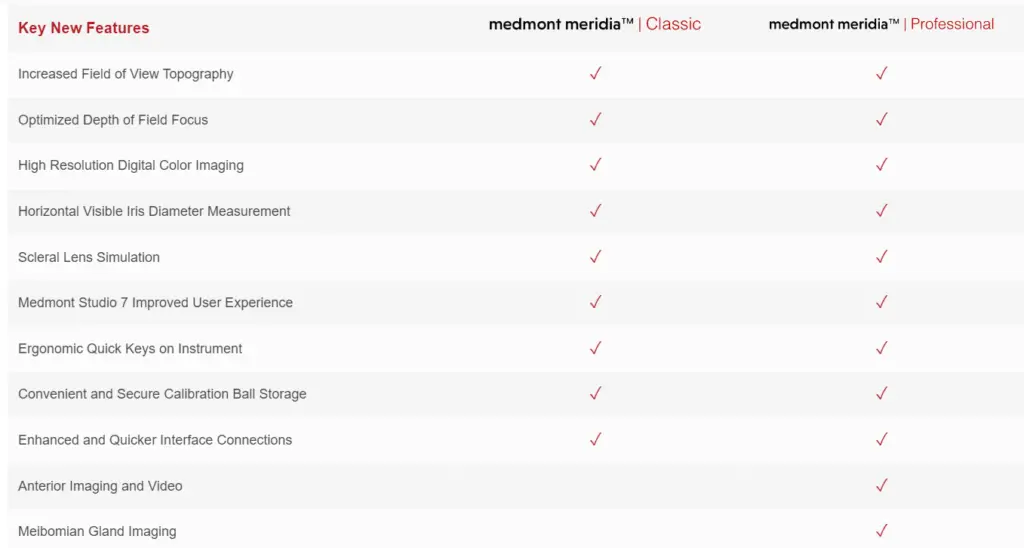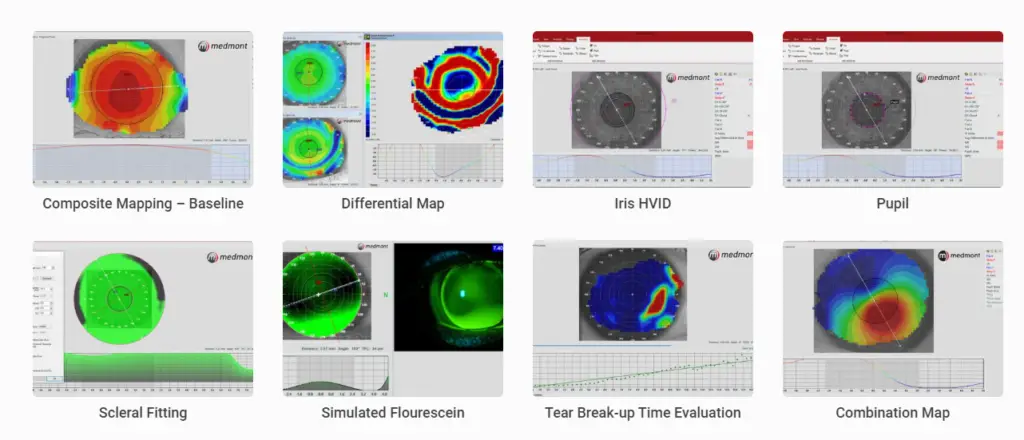Medmont Topographer: A Review of the Corneal Topography Device
Corneal topography is a technique that measures the shape and curvature of the cornea, the clear front surface of the eye. Corneal topography can help diagnose and treat various eye conditions, such as astigmatism, keratoconus, corneal diseases, and post-surgical complications. It can also help fit contact lenses, especially specialty lenses, such as ortho-K lens, scleral lens, and hybrid lenses.
Medmont International Pty Ltd. is a leading provider of precision diagnostic instruments and software solutions for global specialty eye care.

Medmont offers two models of corneal topographers:
- The E300 Corneal Topographer and
- The medmont meridia™ advanced topographer
The medmont meridia™ advanced topographer

the medmont meridia Advanced topographer

Precision and Control: Topography is a complex discipline that demands precision, control, and dexterity. The Medmont Meridia platform understands the unique needs of clinical professionals and patients alike. It acknowledges that without these essential elements, the outcomes of procedures can be compromised.
Ergonomic Design: One of the standout features of the Medmont Meridia platform is its advanced ergonomic design. This design has been meticulously crafted to ensure that clinicians can work with maximum comfort and efficiency. The platform is designed to fit naturally into the hand, minimizing fatigue during prolonged use.
Quick Keys: The inclusion of five quick keys on the instrument is a testament to the Medmont Meridia’s commitment to simplifying the topography process. These quick keys allow clinicians to access essential functions quickly, reducing the need for complex navigation through menus. This not only saves time but also enhances precision.
Software Guidance Tools: In addition to its physical design, the Medmont Meridia platform also boasts sophisticated software guidance tools. These tools serve as invaluable aids for clinicians, providing step-by-step guidance and visual cues. They streamline the topography process, making it more intuitive and less prone to errors.
All-in-One Platform: The Medmont Meridia platform is an all-in-one solution for topographers. It combines the hardware and software needed for topography procedures into a single, cohesive unit. This integration eliminates the need for multiple devices, reducing clutter and optimizing space usage in clinical settings.
Efficient Workflows: Efficiency is a key factor in modern healthcare. The Medmont Meridia platform encourages efficient workflows, allowing clinicians to focus on their patients rather than grappling with complex equipment. With its quick keys and software guidance tools, the platform simplifies the topography process, ensuring that procedures are performed smoothly and accurately.
Standardization: Standardization is vital in healthcare, as it ensures consistent and high-quality care for patients. The Medmont Meridia platform facilitates standardization by offering a reliable and user-friendly solution that clinicians can adopt across their practice. This standardization not only benefits healthcare professionals but also improves the patient experience.
The E300 Corneal Topographer a

Medmont E300 is topographer of choice in most clinical studies. The E300 has built a reputation as THE STANDARD topographer on the market that others are measured against for fitting specialty contact lenses.
Performance Matters… The E300 with its small-cone placido disc design, allows for precise and actual captured data across the cornea that you can’t get elsewhere. Other large-cone placido disc systems are prone to data loss, which leads to you guessing.
First Fit Success With a goal of success with the first fit, the E300 optimizes throughput and reduces rework with proven precision and repeatability. This design focused on precision enables first fit success reducing chair time and satisfied patients. All Medmont topographers include one of the largest database of contact and OrthoK lens designs.
In this article, we will review some of the features, benefits, and drawbacks of these devices.
Features of Medmont Topographers
Medmont topographers have several features that aim to simplify the workflow and optimize the efficiency of an eye care practice. Some of these features are:
Customizable exam templates: Medmont topographers allow users to customize fields, dropdowns, exam types, fast plans, and more to suit their preferences and needs. Users can also select from ready-to-use fast plans that can save time and ensure accuracy.
Seamless device integration: Medmont topographers can seamlessly integrate with various diagnostic equipment, such as OCT, fundus camera, visual field, and more. Users can quickly and easily view and interpret high-definition images without leaving the software.
Drawing tool: Medmont topographers have a drawing tool that enables users to document detailed findings and their location on a graphical representation of the eye. Users can also annotate and edit the drawings as needed.
Diagnosis, plan, and coding: Medmont topographers help users to diagnose, plan, and code with ease. Users can select from a list of common diagnoses and plans, or create their own custom ones. Users can also generate accurate codes based on the exam data.
Direct messaging: Medmont topographers have a direct messaging feature that allows users to communicate securely with other providers, patients, or staff within the system. Users can also attach files, images, or reports to the messages.
Non-Invasive Dry Eye Excellence A study conducted by the University of Melbourne determined the E300’s Auto TBUT dry eye analysis is is repeatable, more sensitive and specific than fluorescein, and provides the user with a non-invasive measure of tear-breakup in line with the DEWSII report recommendations.
Benefits of Medmont Topographers
Medmont topographers can provide several benefits to an eye care practice, such as:

The provided information details the various features and capabilities of a map display system, presumably used in the field of ophthalmology or optometry. This system appears to be a comprehensive tool for eye care professionals, aiding in the assessment of various eye parameters and facilitating contact lens fitting. Let’s delve into the key components of this system:
Map Displays:
- Tangential Curvature/Power: Provides information about the tangential curvature or power of the cornea or other eye structures.
- Axial Curvature/Power: Displays data related to the axial curvature or power of the eye.
- Height: Represents the height or elevation information of the eye’s surface.
- Elevation from Sphere: Indicates the elevation of specific points on the eye’s surface from a reference sphere.
- Refractive Power: Offers data about the refractive power of the eye, essential for vision correction.
- Ray Error: Shows discrepancies or errors in the path of light rays through the eye.
- Wavefront Error: Displays information regarding wavefront aberrations in the eye.
- Tear Film Surface Quality: Assesses the quality of the tear film, crucial for contact lens fitting.
Contact Lens Fitting:
- Multicurve: Supports the fitting of contact lenses with multiple curvature profiles.
- Aspherics: Facilitates the fitting of aspheric contact lenses designed to correct aberrations.
- Keratoconic Designs: Includes specialized designs for patients with keratoconus, a corneal disorder.
- Scleral: Aids in fitting scleral lenses, which cover a larger portion of the eye’s surface.
- Custom Surfaces: Allows for the creation of custom contact lens surfaces to meet unique patient needs.
- Custom Laboratory Lens Designs: Supports the development of bespoke contact lens designs in a laboratory setting.
Shape Descriptors:
- Astigmatism Measurement: Measures the degree and axis of astigmatism in the eye.
- E, p, Q, e2 values: These are likely descriptors or parameters used to characterize specific eye shapes and conditions.
Global Indices:
- SAI (Surface Asymmetry Index): A metric that quantifies asymmetry in the eye’s surface.
- SRI (Surface Regularity Index): An index indicating the regularity of the eye’s surface.
- I-S value: This value likely represents an important global index relevant to eye assessment.
Regression Analysis:
- Orthokeratology Subtractive Maps: These maps are likely used in orthokeratology, a non-surgical procedure to reshape the cornea and correct vision.
User Defined Attributes (Microsoft Windows™ Based Software):
- Inter/Intra Network Compatible: The software can be used on both local and wider networks for data sharing and collaboration.
- EMR/EHR Interface: Supports integration with Electronic Medical Records or Electronic Health Records systems for seamless patient data management.
- DICOM Interface: Enables compatibility with the Digital Imaging and Communications in Medicine (DICOM) standard for medical image exchange.
- USB Computer Interface: Allows the system to connect to a computer via USB for data transfer and control.
Pupil, Iris, HVID Measurement: This feature assists in measuring the size and characteristics of the pupil, iris, and horizontal visible iris diameter (HVID), which are crucial in various aspects of eye care, including lens fitting and surgery planning.
In summary, this map display system, coupled with its advanced software and capabilities, provides a comprehensive toolkit for eye care professionals, aiding in eye assessment, contact lens fitting, and data management. It offers precise measurements, supports customization, and integrates with modern healthcare systems for enhanced patient care.
Increased productivity and profitability: Medmont topographers can help users to document exam data quickly and correctly, reducing errors and increasing efficiency. Medmont topographers can also help users to generate more revenue by optimizing coding and billing processes.
Improved patient care and satisfaction: Medmont topographers can help users to provide better patient care by accessing comprehensive and accurate patient records, images, and reports. Medmont topographers can also help users to enhance patient satisfaction by offering timely delivery and service, discounts and incentives, and secure communication.
Drawbacks of Medmont Topographers
Medmont topographers may also have some drawbacks that users should be aware of, such as:
Learning curve: Medmont topographers may require some time and training to learn how to use them effectively. Users may need to adjust their workflow and habits to adapt to the new system.
Technical issues: Medmont topographers may encounter some technical issues or glitches that may affect their performance or functionality. Users may need to contact the support team or troubleshoot the problems themselves.
Cost: Medmont topographers may have a high cost compared to other corneal topography devices. Users may need to pay a monthly fee per provider or per location, depending on their plan. Users may also need to pay extra for additional services or features.
Conclusion
Medmont topographers are corneal topography devices that offer several features, benefits, and drawbacks for eye care professionals. They are designed to simplify the workflow and optimize the efficiency of an eye care practice. Users should weigh the pros and cons of Medmont topographers before deciding whether they are suitable for their needs.
Follow us in Facebook
Discover more from An Eye Care Blog
Subscribe to get the latest posts sent to your email.

You must be logged in to post a comment.